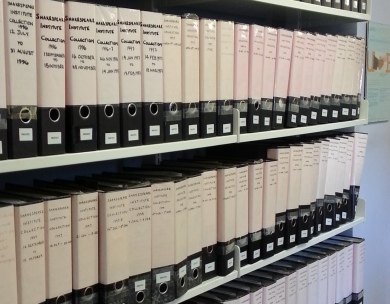The Shakespeare Institute Library collection of press cuttings is an invaluable treasure trove for the theatre historian and Shakespearean researcher.
In libraries around the world – both academic and public – there has been a great push toward digitisation of resources in the past decade. Google is cashing in on digitisation of books as a marketable genre and Amazon’s Kindle and its imitators are popular with commuters. Academic journals have gone digital to increase their outreach and downsize publishing costs (while on the whole not reducing their prices, it should be noted) and some have ceased hard copy publication entirely and live only in cyberspace. Pressure on shelf space has also contributed to this digitisation craze in libraries, which partially explains their collective advocacy of shifting the place of information resource material more and more towards the world wide web. As more and more books and volumes of journals are published in “traditional” form, there is the constant problem of not having the shelf space for them – rare (perhaps non-existent) is the university that provides MORE space for its library, even for the output of its academics.

Digitisation of resources has provided increased access to information – particularly in the realm of newspapers and broadcast news content. Subscription services such as Nexis are now vast repositories of news and information that has greatly expanded the ability of the researcher to explore national and international content from the convenience of the nearest computer or mobile device. Likewise, individual newspapers now also archive several years’ worth of content on their websites. Each of these have search functions, but the downside to them is that search engines link to specific key words for each article. This is not foolproof and it can be decidedly lazy and – importantly – the researcher can miss crucial information if s/he is too reliant on sitting behind a desk and tapping on a keyboard. Just as a good browse in a bookshop or a library can yield an undiscoverd gem, so too can a good trawl through newscuttings yield eureka moments for the theatre historian.
Take the wonderful Beaverbook Collection of newscuttings in the Shakespeare Institute Library, for example, which contains Shakespeare-related articles dating from 1902. I used this part of the SIL press cuttings collections heavily in my doctoral research, which was on contemporary Shakespearean productions which used the 1930s as a period setting. In providing context for the late twentieth and early twenty-first century’s use of 1930s signifiers, I delved eagerly into the history of modern dress productions staged in the 1920s and 1930s. I want to stress that this information is almost uniformly NOT available on the internet. Instead the crucial clues to the ephemeral art of theatre reside within the writings from the era, the focal point of which are newspaper coverage of productions. In Barry Jackson’s report to the Daily Express of his first “experiment” with modern dress at the Birmingham Rep in 1923, you see the kernal of the ongoing debate about contemporary Shakespeare: “I want to bring out his humanity. I want to make [Shakespeare’s] creations live as flesh and blood today.” In the reviews of those shows, you also find details that flesh out how Jackson and his director, H. K. Ayliff, achieved this fleshing out, as with this description of their 1928 Taming of the Shrew in the Birmingham Mail: “There is, for instance, the way in which Curtis says ‘There’s fire ready,’ and thereupon calmly produces an electric heater. But of the many examples the gem is the motor scene, representing Petruchio and Kate returning to Padua. Imagination – and perversity – could hardly have achieved a bigger joke, kept within the strict letter of the script, than Mr. Ayliff’s fitting of Petruchio’s opening exclamation, ‘Come on, i’God’s name’ to a stranded motorist churning round the starting handle of this car.” In these passages – and others preserved in the SIL’s newscuttings collection – can be observed the genesis of one common approach to staging Shakespeare that continues into the twenty-first century with actors using modern objects to illustrate meaning within performance.

My post-doctoral work continues to rely heavily on the SIL’s vast collection of newscuttings and in each of my publications, I have extensively consulted the precious history contained within. An interview with Antony Sher and Peter Flannery on the eve of the opening of the latter’s play Singer at the RSC in 1989 plays its part in illuminating my argument about the contemporaneity of Richard Eyre’s 1990 production of Richard III in my Shakespeare Bulletin article “The ‘Fascism and Its Consequences Season: Richard Eyre’s Richad III and Its Historical Moment”. For my stage history of Troilus and Cressida published in Shakespeare, which charts the gradual decline in feminst Cressidas the SIL cuttings were invaluable as I charted both reception and staging of Cressida’s scenes from Juliet Stevenson’s influential portrayal through to the Globe’s 2009 production. Finally, my most recent article “The Shakespearean Glass Ceiling: the State of Colorblind Casting in Contemporary British Theatre” would have contained less context without the SIL newscuttings collection. The discoveries I made in trawling through the mass of articles enabled me to hang my argument on an assumption on the part of arts journalism discovered within the collection that equality in casting has been achieved. That pervasive theme within the holdings of the SIL and other repositories is disturbing and has been largely debunked by my research into casting practices in contemporary theatre. Without trawling the SIL press cuttings, I would never have been able to see the pattern – as patterns are difficult to detect in searches that focus exclusively on electronic sources. The physical items contained the clue as I leafed through year after year of Shakespearean coverage housed in the pink and black binders of the Shakespeare Institute Library.
In short, the SIL’s newcuttings collection is a vast and invaluable resource to researcher and Shakespearean student. I urge you, Reader, to discover its pleasures and treasures for yourself.
Dr Jami Rogers
Alumna of the Shakespeare Institute, University of Birmingham


Reblogged this on Shakespeare Institute Library News Collection.